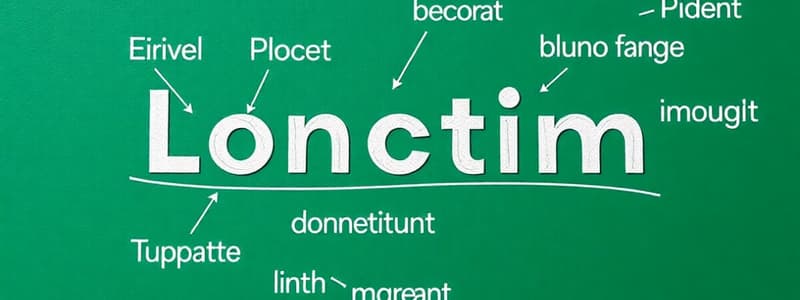Podcast
Questions and Answers
What is the relationship between denotation and connotation?
What is the relationship between denotation and connotation?
- Denotation and connotation are synonyms and can be used interchangeably.
- Denotation is the implied meaning, while connotation is the literal meaning.
- Denotation is the literal meaning, while connotation is the implied meaning. (correct)
- Denotation is the opposite of connotation, expressing contrasting meanings.
Which Latin term is denotation derived from?
Which Latin term is denotation derived from?
- denotem
- denotationem (correct)
- denotare
- denotatus
Which example best illustrates a positive connotation?
Which example best illustrates a positive connotation?
- Dwelling
- Oddity
- Home (correct)
- Quirk
In "The Bean Eaters," the word "twinklings" evokes a sense of:
In "The Bean Eaters," the word "twinklings" evokes a sense of:
Which word has a more negative connotation: 'quirk' or 'oddity'?
Which word has a more negative connotation: 'quirk' or 'oddity'?
In "The Bean Eaters," how does the word "twinges" contrast with "twinklings"?
In "The Bean Eaters," how does the word "twinges" contrast with "twinklings"?
What is the primary factor that shapes a word's connotation?
What is the primary factor that shapes a word's connotation?
In the given excerpt of "The Adventures of Tom Sawyer," what does the term "simple-hearted" suggest about Aunt Polly?
In the given excerpt of "The Adventures of Tom Sawyer," what does the term "simple-hearted" suggest about Aunt Polly?
How does the word "transparent" characterize Aunt Polly's attempts at "dark and mysterious diplomacy"?
How does the word "transparent" characterize Aunt Polly's attempts at "dark and mysterious diplomacy"?
What role does diction play in literature?
What role does diction play in literature?
What is the overall effect of Twain's use of connotative language in describing Aunt Polly?
What is the overall effect of Twain's use of connotative language in describing Aunt Polly?
What is the Latin root of the word 'connotation'?
What is the Latin root of the word 'connotation'?
Which of the following best describes 'diction'?
Which of the following best describes 'diction'?
Which theme is explored in "The Bean Eaters" through the contrasting connotations of "twinklings" and "twinges"?
Which theme is explored in "The Bean Eaters" through the contrasting connotations of "twinklings" and "twinges"?
How does the author's word choice in both excerpts contribute to the portrayal of the characters?
How does the author's word choice in both excerpts contribute to the portrayal of the characters?
Flashcards
Imagery
Imagery
Descriptive language that creates visual representations in the reader's mind.
Theme of Aging
Theme of Aging
The central message about growing older and its impact on life appreciation.
Connotation of 'Twinklings'
Connotation of 'Twinklings'
The emotional and cultural associations of twinklings as magical or nostalgic.
Denotation vs. Connotation
Denotation vs. Connotation
Signup and view all the flashcards
'Twinges' in Context
'Twinges' in Context
Signup and view all the flashcards
Aunt Polly's Characterization
Aunt Polly's Characterization
Signup and view all the flashcards
Transparent Motives
Transparent Motives
Signup and view all the flashcards
Denotation
Denotation
Signup and view all the flashcards
Connotation
Connotation
Signup and view all the flashcards
Example of Denotation
Example of Denotation
Signup and view all the flashcards
Positive Connotation
Positive Connotation
Signup and view all the flashcards
Negative Connotation
Negative Connotation
Signup and view all the flashcards
Diction
Diction
Signup and view all the flashcards
Literal Meaning
Literal Meaning
Signup and view all the flashcards
Emotive Language
Emotive Language
Signup and view all the flashcards
Study Notes
Connotation and Denotation
- Connotation and denotation are two ways to understand word meaning.
- Denotation: The dictionary definition, the literal meaning.
- Connotation: The emotional or feeling associated with a word, beyond the literal meaning. Context and usage shape connotation.
Denotation
- Denotation originates from Latin, meaning "to note."
- Denotation is the word's literal, dictionary meaning.
- Multiple meanings exist for many words; examples use primary definitions.
Denotation Examples
- Quirk: A peculiar trait.
- Oddity: An unusual person, thing, or event.
- Dwelling: A home or shelter.
- Home: A place of residence.
Connotation
- Connotation originates from Latin, meaning "to signify additionally."
- Connotation is the emotion or feeling a word conveys.
- Usage shapes the connotation.
Connotation Examples
- Quirk vs. Oddity: Both denote a peculiar trait, but "quirk" is positive (cute, acceptable), while "oddity" is negative (less acceptable).
- Dwelling vs. Home: Both denote a place to live, but "dwelling" is neutral/negative (structure, lack of connection), while "home" is positive (warmth, belonging).
Connotation and Denotation Examples in Literature
- Word choice (diction) is key in literature to convey meaning.
- Words evoke images and emotions.
Examples from Literature
- "The Bean Eaters" by Gwendolyn Brooks:
- "twinklings": Positive connotation, evoking nostalgia, magical images; denotation is "intermittent gleams of light."
- "twinges": Suggests recurring discomfort or pain, contrasting with "twinkling" ; denotation is a sudden sharp pain.
- "The Adventures of Tom Sawyer" by Mark Twain:
- "simple-hearted": Denotes free from deceit, but connotation portrays naiveté, kindness, and being outmatched in wits.
- "transparent": Denotes having easily perceived motives; connotation suggests a lack of skill in hiding intentions, and also a humorous play on the person's perceived cleverness.
Studying That Suits You
Use AI to generate personalized quizzes and flashcards to suit your learning preferences.




